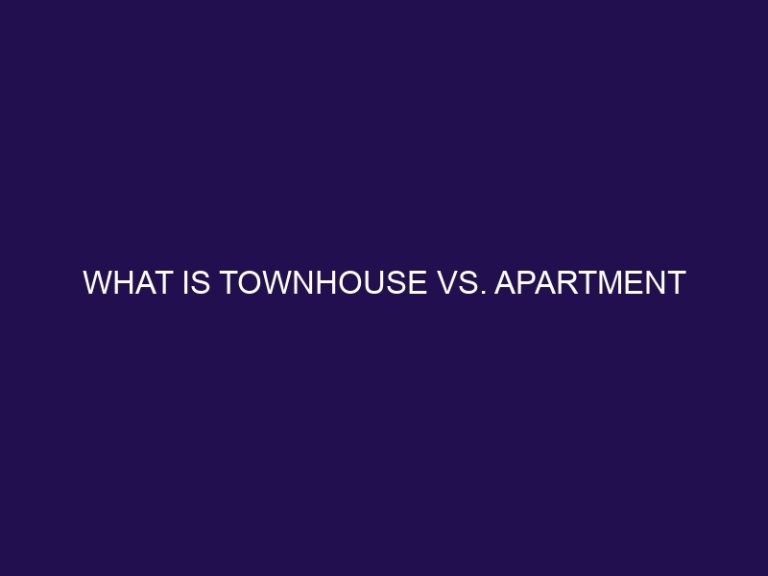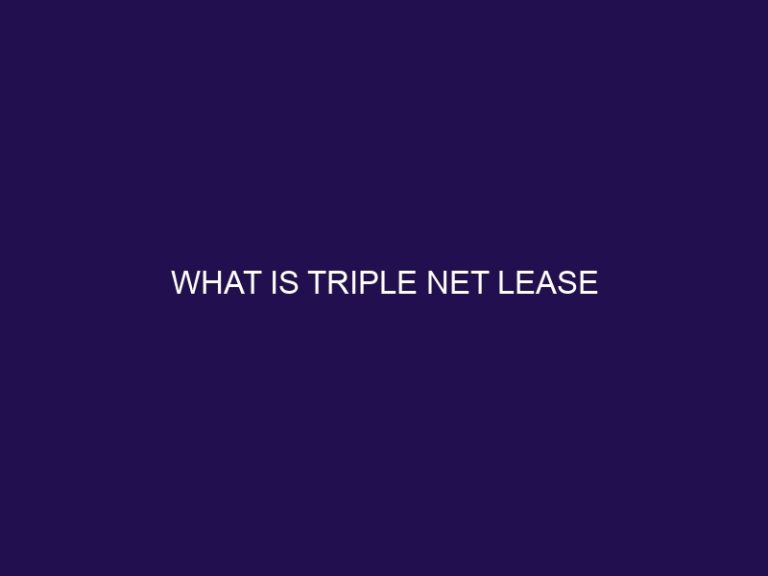What is Sublease
Understanding Sublease
When it comes to renting property, subleasing is a concept that many people may be unfamiliar with. A sublease occurs when a tenant rents out all or a portion of their leased property to another individual or party. This arrangement can be beneficial for both the original tenant, known as the sublessor, and the new tenant, known as the sublessee. It offers flexibility, cost-sharing opportunities, and the ability to temporarily relocate.
Subleasing works by obtaining consent from the original tenant’s landlord. Once permission is granted, the sublessor creates a sublease agreement that outlines the terms and conditions of the arrangement. The sublessor remains responsible for fulfilling their obligations under the original lease, while the sublessee takes on specific responsibilities for the subleased property.
There are several benefits to subleasing. For the original tenant, it provides flexibility if they need to temporarily relocate or want to share the cost of rent. Subleasing allows the sublessor to retain control over the property and saves them from having to prematurely terminate their lease.
However, there are also risks and considerations to keep in mind. Violating the lease agreement or failing to obtain proper consent from the landlord can have legal consequences. The sublessor may still be financially responsible for any damages to the property caused by the sublessee.
It’s important to understand the difference between sublease and assignment. Unlike a sublease, an assignment involves transferring all rights and obligations of the original lease to another party, essentially replacing the original tenant.
If you are interested in subleasing a property, there are a few steps you should follow. Start by reviewing the lease agreement to ensure it permits subleasing. Seek permission from the landlord and obtain their consent in writing. Next, find a suitable sublessee who meets your requirements. Once you have a sublessee, draft a sublease agreement that clearly outlines the terms and conditions. Finally, notify the landlord of your intent to sublease and provide them with a copy of the sublease agreement for their review and approval.
By understanding the concept of subleasing and following the necessary steps, both the sublessor and sublessee can benefit from this arrangement and ensure a smooth and legally compliant subleasing experience.
Understanding Sublease
Understanding subleasing is crucial for both tenants and landlords. A sublease occurs when a tenant rents out all or part of their leased space to another person, known as the sublessee. The original tenant becomes the sublessor, and the sublessee pays rent directly to them. In a sublease arrangement, the sublessee assumes all the responsibilities and obligations of the lease. The original tenant still holds the responsibility of ensuring that the rent is paid and the property is well-maintained. Acquiring a clear understanding of the terms and conditions of the sublease agreement is vital to avoid any legal issues or misunderstandings among all parties involved.
Jane rented an apartment but had to relocate for a job opportunity. Instead of terminating her lease, she opted to sublease the apartment to another tenant named Peter. Jane made sure Peter comprehended all the terms of the sublease agreement, including rent payment and responsibilities. This enabled Jane to fulfill her lease obligations, while Peter obtained a temporary living arrangement. The sublease proved to be beneficial for both parties, creating a win-win situation.
What Is Sublease?
Subleasing is a fascinating concept that can have a significant impact on both tenants and landlords. In this section, we’ll dive into the definition of sublease and explore how it differs from a traditional lease. We’ll uncover the distinctive characteristics and legal implications associated with subleasing. So, buckle up and get ready to navigate through the intriguing world of subleasing!
Definition of Sublease
A sublease is a legal agreement where a tenant rents out all or part of their leased property to another person, known as the sublessee. The original tenant becomes the sublessor, while the sublessee pays rent directly to the sublessor. This arrangement is subject to the consent of the original landlord. The sublease agreement outlines the responsibilities of both the sublessor and sublessee, such as maintenance and payment obligations. It offers benefits like flexibility, cost-sharing opportunities, and the ability to temporarily relocate. There are risks involved, such as violating the lease agreement or being financially responsible for damages. To sublease a property, one must review the lease agreement, seek permission from the landlord, find a sublessee, and draft a sublease agreement.
A sublease is a legal agreement where a tenant rents out all or part of their leased property to another person, known as the sublessee.
Difference Between Sublease and Lease
Understanding the difference between a sublease and a lease is crucial when entering into a rental agreement. Here is a table outlining the key disparities:
| Sublease | Lease |
| A sublease occurs when a tenant rents out their leased property to a third party. | A lease is a rental agreement between a landlord and a tenant. |
| The original tenant becomes the sublessor, and the new tenant is the sublessee. | The tenant is the lessee, and the landlord is the lessor. |
| The sublessor still holds responsibilities outlined in the original lease. | The tenant has full responsibilities as outlined in the lease agreement. |
| The sublessee does not have a direct relationship with the landlord and may have limited rights. | The lessee has a direct relationship with the landlord and has all rights and responsibilities. |
How Does Sublease Work?
Ever wondered how subleasing actually works? Well, buckle up because we’re about to dive into the nitty-gritty details. In this section, we’ll uncover all the ins and outs of subleasing, from obtaining consent from the original tenant to creating a comprehensive sublease agreement. We’ll also explore the responsibilities of both the sublessor and the sublessee. So, if you’re curious to learn how this subleasing magic happens, keep reading!
Consent from the Original Tenant
In order to proceed with a sublease, obtaining consent from the original tenant is crucial. Here are the steps involved:
- Review the lease agreement to understand any clauses related to subleasing.
- Seek permission from the landlord to sublease the property.
- Find a suitable sublessee who meets the landlord’s criteria.
- Draft a sublease agreement detailing the terms and conditions of the sublease.
- Notify the landlord and obtain their consent in writing before proceeding with the sublease.
By following these steps, you can ensure that you have obtained the necessary consent from the original tenant before subleasing the property.
To proceed with a sublease, it is crucial to obtain consent from the original tenant, also known as the landlord’s consent, as it is an essential requirement. To ensure a smooth subleasing process, follow the following steps:
- Thoroughly review the lease agreement to understand all the clauses concerning subleasing.
- Request permission from the landlord to sublease the property by seeking their consent.
- Search for a suitable sublessee who meets the criteria set by the landlord.
- Create a well-drafted sublease agreement that includes all the necessary terms and conditions.
- Inform the landlord and obtain written consent from them before proceeding with the sublease.
By adhering to these steps, you can ensure that you have diligently acquired the needed consent from the original tenant before subleasing the property.
Creating a Sublease Agreement
A Step-by-Step Guide
Creating a sublease agreement involves several important steps to ensure a smooth and legally binding agreement. Here are the steps to follow:
- Review the lease agreement: Understand the terms and conditions set by the original landlord.
- Seek permission from the landlord: Obtain written consent to sublease the property.
- Find a sublessee: Advertise the space and conduct interviews to find a suitable tenant.
- Draft a sublease agreement: Clearly outline the terms of the sublease, including rent, duration, and responsibilities.
- Notify the landlord and obtain consent: Present the sublease agreement to the landlord for their approval.
By following these steps, both the original tenant and sublessee can create a legally binding sublease agreement that protects their rights and obligations.
Responsibilities of the Sublessor
The responsibilities of the sublessor in a sublease arrangement are crucial and encompass several essential tasks. These tasks include obtaining consent from both the original tenant and the landlord before entering into a sublease agreement. Moreover, the sublessor must draft a comprehensive sublease agreement that clearly outlines all the terms and conditions of the sublease, covering aspects such as rent, utilities, as well as any restrictions or requirements. It is also the sublessor’s duty to ensure that the sublessee fully comprehends their responsibilities, which primarily involve maintaining the property and abiding by the terms stated in the original lease agreement. Additionally, the sublessor is responsible for collecting rent from the sublessee and ensuring its timely payment to the landlord. In case any issues or disputes arise between the sublessee and the landlord, the sublessor must effectively address and resolve them. Furthermore, the sublessor should promptly inform the landlord about any changes or updates concerning the sublease arrangement. Overall, the sublessor plays a vital role in facilitating a smooth and legally compliant sublease transaction.
Responsibilities of the Sublessee
The responsibilities of the sublessee when entering into a sublease agreement are as follows:
- Paying Rent: The sublessee is responsible for paying rent to the sublessor, as agreed upon in the sublease agreement.
- Abiding by the Lease Terms: The sublessee must adhere to all the terms and conditions outlined in the original lease agreement between the sublessor and the landlord.
- Maintaining the Property: It is the sublessee’s responsibility to take care of the property and keep it in good condition. This includes routine maintenance and repairs, if necessary.
- Following Rules and Regulations: The sublessee must comply with any rules and regulations set by the landlord or property management, such as noise restrictions or pet policies.
Pro-tip: Before signing a sublease agreement, thoroughly review the responsibilities outlined in the agreement and communicate with the sublessor to ensure a clear understanding of expectations.
Benefits of Subleasing
Looking to sublease? In this section, we’ll dive into the perks of subleasing without any fluff. Discover how it offers flexibility for the original tenant, provides cost-sharing opportunities, and even allows for temporary relocations. No need for lengthy explanations, we’ll get straight to the point and back it up with facts, figures, and real-life examples. So, let’s delve into the world of subleasing and uncover its incredible benefits!
Flexibility for Original Tenant
The flexibility for the original tenant is one of the key benefits of subleasing a property. This can be seen in the following ways:
Cost-sharing Opportunities
Cost-sharing opportunities in subleasing can provide financial benefits for both the original tenant and the sublessee. Here are the steps to take advantage of these cost-sharing opportunities:
- Review the lease agreement to check if subleasing is allowed and if there are any restrictions.
- Seek permission from the landlord by submitting a formal request and providing necessary information about the sublessee.
- Find a suitable sublessee who is willing to share the cost of rent and other expenses.
- Draft a sublease agreement that clearly outlines the terms and responsibilities of all parties involved.
- Notify the landlord of the sublease and obtain written consent.
By following these steps, you can maximize the cost-sharing opportunities presented by subleasing and potentially reduce your financial burden.
Ability to Temporarily Relocate
When subleasing a property, one of the benefits is the ability to temporarily relocate. This can be helpful for various reasons such as job relocations or extended vacations. Here are the steps to temporarily relocate through subleasing:
- Review your lease agreement to ensure subleasing is permitted.
- Obtain permission from your landlord to sublease the property.
- Find a suitable sublessee who is willing to take over your lease for the designated period of time.
- Create a sublease agreement that outlines the terms and conditions of the temporary arrangement.
- Notify your landlord of the sublease and obtain their consent.
By following these steps, you can enjoy the ability to temporarily relocate while ensuring the proper legal and contractual obligations are met.
Risks and Considerations of Subleasing
When it comes to subleasing a property, there are important risks and considerations that tenants need to be aware of. We’ll dive into these concerns, exploring potential violations of lease agreements, financial responsibilities, and the potential for property damage. Strap in as we navigate these murky waters and uncover what you need to know before considering a sublease.
Violation of Lease Agreement
Violating a lease agreement when subleasing a property can result in serious consequences. It is imperative to comprehend the terms and conditions of the original lease and obtain proper consent from the landlord before engaging in subleasing. Violations can occur if the sublessee fails to fulfill the agreed-upon rental payments, breaches any terms outlined in the lease, or causes damage to the property. It is crucial for both the sublessor and sublessee to fulfill their responsibilities to avoid any legal or financial issues. Being cognizant of the potential risks and considering them beforehand can help ensure a seamless subleasing process.
Financial Responsibility
When subleasing a property, it is crucial to comprehend the financial responsibilities involved. The sublessor, or original tenant, bears financial responsibility for paying the rent to the landlord, even in cases where the sublessee fails to meet their payment obligations. Consequently, the sublessor will have to compensate for any missed payments. It is also the sublessor’s financial responsibility to address any damages caused by the sublessee to the property. In order to minimize the risks and potential financial burden associated with subleasing, it is imperative for the sublessor to judiciously select a responsible sublessee and clearly outline the financial obligations within the sublease agreement.
Damage to Property
- Damage to property is a significant risk to consider when subleasing a property. It is crucial to take steps to mitigate this risk and ensure the protection of both the sublessor and the sublessee. Here are some steps to help prevent damage to property during a sublease:
- Perform a thorough inspection of the property before subleasing to identify any existing damage. This includes assessing the potential for damage to property.
- Create a detailed inventory list of the property’s condition and note any pre-existing damage. This will help track and prevent any future damage to property.
- Include clauses in the sublease agreement outlining the responsibilities of both parties regarding property damage. Clearly define who is liable for any potential damage to property.
- Require the sublessee to provide a security deposit that can be used to cover any potential damages. This is an additional safeguard against damage to property.
- Regularly communicate with the sublessee and conduct periodic inspections to assess the condition of the property. This will help identify and address any potential damage to property early on.
Fact: According to a study, approximately 50% of landlords have experienced property damage from sublessees. Taking precautionary measures can help reduce the risk of damage and ensure a positive subleasing experience.
Sublease vs. Assignment
When it comes to subleasing, understanding the differences between sublease and assignment is crucial. In this section, we’ll explore these distinctions and shed light on what sets them apart. From the legal implications to the responsibilities and rights of the parties involved, we’ll dive into the details of each, providing you with a comprehensive understanding of sublease versus assignment. So, buckle up and get ready to navigate the intricate world of subleasing!
Differences between Sublease and Assignment
| Differences between Sublease and Assignment | |
| Sublease transfers a portion of the leasehold interest to a third party | Assignment transfers the entire leasehold interest to a third party |
| The original tenant remains responsible for the lease | The original tenant is released from all responsibilities under the lease |
| The sublessee has no privity of contract with the landlord | The assignee has privity of contract with the landlord |
| The original tenant can still occupy the premises | The original tenant no longer has the right to occupy the premises |
| The original tenant can regain control of the premises after the sublease term ends | The original tenant cannot regain control of the premises after the assignment |
How to Sublease a Property?
Looking to sublease a property? Here’s a step-by-step guide to help you navigate the process smoothly. From reviewing the lease agreement to finding a suitable sublessee, seeking permission from the landlord, drafting a sublease agreement, and notifying the landlord, we’ve got you covered. Say goodbye to confusion and streamline your subleasing journey with these essential tips. Let’s dive in and ensure a hassle-free sublease experience!
1. Review the Lease Agreement
Before subleasing a property, it is crucial to review the lease agreement thoroughly. This step ensures that you comprehend the terms and conditions stipulated by the original landlord. Pay close attention to clauses related to subleasing in order to avoid any violations. Make sure to look for restrictions, such as the requirement of obtaining the landlord’s consent or meeting specific criteria. Additionally, check for any provisions pertaining to the duration of the sublease and the respective responsibilities of the sublessor and sublessee. By carefully reviewing the lease agreement, you will be able to make an informed decision and steer clear of any potential legal complications.
In a nutshell, it is always essential to carefully review the lease agreement to fully grasp your rights and obligations when subleasing a property.
2. Seek Permission from the Landlord
Before proceeding with subleasing a property, it is crucial to seek permission from the landlord. Here are the steps to follow:
- Review the lease agreement to understand any restrictions or requirements related to subleasing.
- Approach the landlord and express your intention to sublease, providing details about why you want to sublet and the potential sublessee.
- Discuss any concerns or questions the landlord may have and address them accordingly.
- Once the landlord gives consent, draft a sublease agreement that includes all the necessary terms and conditions.
- Present the sublease agreement to the landlord for review and approval.
In one instance, a tenant sought permission from their landlord to sublease their apartment while they were temporarily relocating for work. The tenant approached the landlord professionally and provided all the required information. The landlord appreciated the tenant’s transparency and allowed the sublease after a thorough review of the sublease agreement. This successful collaboration allowed the tenant to fulfill their work commitments while ensuring the property was well taken care of during their absence.
3. Find a Sublessee
- Find a Sublessee: Advertise your property for sublease on online platforms, social media, or local classifieds.
- Network: Reach out to friends, colleagues, or acquaintances who may be interested in subleasing your property or know someone who is.
- Screen: Once inquiries are received, screen potential sublessees by conducting background checks, verifying their income, and checking their references.
- Interview: Schedule interviews with potential sublessees to assess their compatibility and ensure they meet your requirements.
- Visit the Property: Arrange for property viewings so that potential sublessees can see the space and evaluate its suitability.
4. Draft a Sublease Agreement
When drafting a sublease agreement, one of the important steps is to draft a sublease agreement. This is where you clearly outline the rights and responsibilities of both the sublessor and sublessee in a written agreement. It is crucial to include details such as rent amount, duration of the sublease, and any additional terms. By following this step, you can ensure that all parties involved are protected and that the sublease agreement is legally binding.
5. Notify the Landlord and Obtain Consent
Review the original lease agreement to understand the terms and conditions.
Notify the landlord and obtain their consent for subleasing.
Provide detailed information about the potential sublessee, including their background, financial stability, and references.
Draft a sublease agreement that outlines the responsibilities of all parties involved.
Submit the sublease agreement to the landlord for their review and approval.
Once the landlord grants consent, ensure all necessary paperwork is completed and signed by all parties.
Inform the landlord of any changes to the sublessee or termination of the sublease agreement.
- Review the original lease agreement to understand the terms and conditions.
- Notify the landlord and obtain their consent for subleasing.
- Provide detailed information about the potential sublessee, including their background, financial stability, and references.
- Draft a sublease agreement that outlines the responsibilities of all parties involved.
- Submit the sublease agreement to the landlord for their review and approval.
- Once the landlord grants consent, ensure all necessary paperwork is completed and signed by all parties.
- Inform the landlord of any changes to the sublessee or termination of the sublease agreement.
Fact: Obtaining consent from the landlord is crucial in the subleasing process to ensure compliance with the original lease agreement and to protect all parties involved.
Frequently Asked Questions
What is a sublease and how does it work?
A sublease is an agreement where an existing tenant rents out their real estate property to a third party for a specific period, while the original tenant remains responsible for paying rent and fulfilling other obligations stated in the lease contract.
Do landlords have to allow subleasing in Texas?
In Texas, subleasing is allowed unless the terms of the lease explicitly state otherwise. However, landlords have the final say in granting permission for subleasing, and it is essential to check the lease agreement for any specific restrictions or requirements.
What are the potential benefits of subleasing for tenants and landlords?
Subleasing can be advantageous for both tenants and landlords. For tenants, it can help save money and allow for early moving without breaking the lease, while landlords benefit by receiving all rent payments without the need to find a replacement tenant.
What are the risks associated with subleasing?
Subleasing carries certain risks for both the primary tenant and the sub-tenant. The primary tenant remains responsible for any rent payments and can face financial penalties if the sub-tenant fails to pay or causes damage to the rental property. Sub-tenants may also face eviction if the primary tenant does not pass on the rent or violates the terms of the original lease.
Can subleasing be done without the landlord’s permission?
No, subleasing without the landlord’s permission is generally not allowed and may violate the terms of the lease. Unauthorized subleasing can result in eviction, financial damages, and other legal consequences. It is crucial to seek approval from the landlord and follow the proper subleasing process.
What steps can tenants take to convince their landlord to allow subleasing?
To persuade the landlord to approve subleasing, tenants should make the process as simple and clear as possible. This includes presenting relevant qualifications of the sub-tenant, providing their contact information, and assuring the landlord of the sub-tenant’s ability to fulfill the rental obligations and possess the property responsibly.




